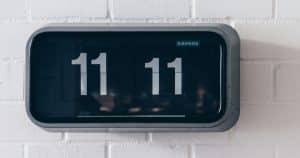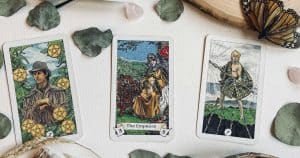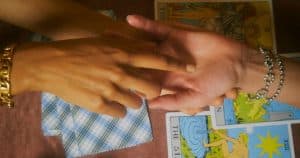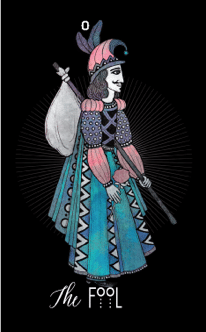Spreads as Templates
The tarot spread you use is a template. When you place each card down, you’re plugging those meanings into each spot to form a timeline or story. The meaning of the card is made more precise when viewed through the lens of the meaning of the position in the spread.
For example, take a past-present-future spread. That’s three cards, with the left card meaning past influence, the middle card meaning present influences or the present situation, and the right-hand card meaning future influences or circumstances. Your question has to do with what’s causing a prickly relationship between you and a relative, and you pull the Empress reversed for the past card, the Six of Cups reversed[1] for the present card, and the Six of Swords upright for the future card.
The Empress reversed, in isolation, can mean over-mothering and smothering, a troublesome pregnancy or inability to get pregnant, and blocked creativity, among other interpretations. So in a spread where this card is in the past position, there was some influence involving one of these factors in the past for one or both of you.
Now take a look at the present card, the Six of Cups reversed. In isolation, this card is about children and memories of childhood that might not be the happiest (remember, this is the reversed version). In a position indicating present situations, this card could indicate that you or your relative is dealing with bad memories. But, when you look at the card along with the Empress reversed in the past position, it looks more like there is something in the relationship between you two that involved one of you possibly smothering the other. Maybe one of you crushed the other’s artistic dreams years ago, and the resentment is coming to the surface now. Or, one of you has been treating the other like a child for much too long, and the “child” is about ready to rebel.
As for the third card, the Six of Swords upright indicates journeys and recovery, and moving on. In a future position, it indicates a potential resolution where the disputes are over, so the relationship moves ahead into calmer waters (many decks show a boat heading from choppy to peaceful waters on this card). When combined with the other two cards, you can see that the relationship — if you continue on your current path — has a chance of reaching a peaceful resolution, either because you both sat down and hashed out your differences, or you decided to cut your losses and cut off the relationship.
So, you see how each card’s individual meanings were refined when linked to the other cards through the spread, and how each card’s meanings applied to a particular time or situation as denoted by the position in the spread.
Note that the spread position is not the be-all-end-all of meanings. You still have to apply the meaning of the card and position to the overall story you’re getting from the full spread and from your knowledge of the situation behind the question, if any. For example, the second-to-last card of the Celtic Cross is usually about your hopes or fears regarding the question. If you’ve asked about the outcome of a job interview and see the Three of Swords, or “Sorrow,” that could be a straight-up fear, either that you won’t get the job, or, if you’re not enthusiastic about that job, that you’ll actually pass and get an offer.
When Versions Attack
All that seems simple enough, assuming you practice and memorize all the meanings. It becomes more complicated, though, when you’re faced with different versions of the same basic spread. Like dialects of languages, these versions are essentially the same spread, but with distinct variations in some of the position meanings.
The Celtic Cross is a classic case. In the cross portion, you have two cards in the middle, ringed by four cards. One version of the spread has these as (starting at the bottom, going clockwise) reason for asking the question, past influences, present situation, and short-term outcome. Another version has these as present situation, past influences, present influences, and future influences. And to make things even more confusing, some readers look at the bottom, left, top, and right, while others look at the bottom, then top, then left, and right. That can change the interpretation somewhat, depending on the card.
If you’re just learning to read tarot cards and find different versions of the same spread, it’s OK to play around with both and see which version resonates with you. However, if you have a spread read by another person, you need to be aware of which version that person uses so that you don’t end up confused.
New Designs and New Meanings
A step that many tarot readers take as they gain confidence in their knowledge of the cards is to create their own spreads. So as you learn more and investigate more websites and books, you’ll find more spreads with increasingly diverse card-position readings. You’ll see interpretations that appear in many spreads, like past influences, while other position interpretations may be unique to that spread.
Dual Options
One more issue is that the position meaning can be maddeningly vague. Take that “other people’s involvement” card in the Celtic Cross (second up from the bottom in the “staff” portion of the spread). This position refers to other people’s thoughts about the situation, their actions, and their involvement with you. It’s often used to indicate whether other people will support or oppose you, but it can also indicate how people are reacting to your actions, meaning that a card that looks very unsupportive could really mean that you’re not being very supportive of others. Or your behavior is so uncalled-for that they are not going to be supportive of you. So the position is really about more than just whether others like your side of the story.
Look at the whole spread to see how each position works with the others. When you’ve place each card down, look at the meaning of the card, then the meaning through the lens of the position, and then the meaning through the lens of the entire spread.
The flexibility of the position meanings can take getting used to, but in a way, it’s a blessing. It allows you to discover additional possibilities that could be more in tune with what you’ve noticed in the situation so far. If you want to see more variation regarding spreads and interpretations, a professional online tarot reading is a great place to start.












